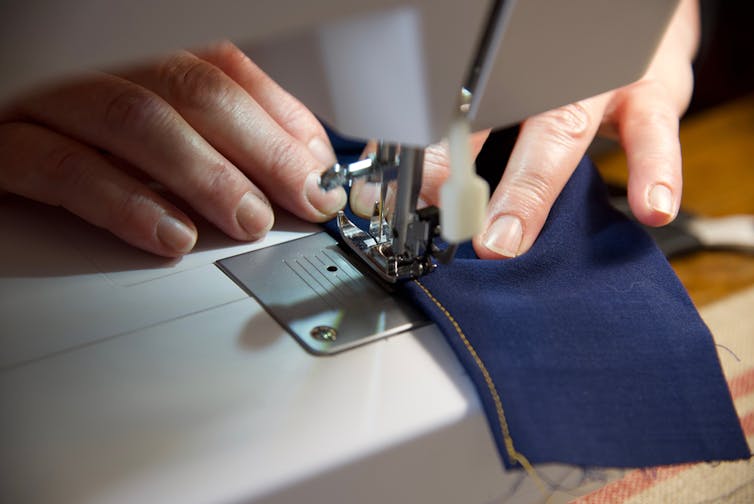C Raina MacIntyre, UNSW; Abrar Ahmad Chughtai, UNSW; Charitha de Silva, UNSW; Con Doolan, UNSW; Prateek Bahl, UNSW, and Shovon Bhattacharjee, UNSW
If you’re not sure whether wearing a face mask is worth it, or you need to wear a mask but are unsure which type, our new research should help you decide.
We took videos of what happens when you talk, cough and sneeze in different scenarios — while not wearing a mask, wearing two different types of cloth masks, or wearing a surgical mask.
The results, published today in the journal Thorax, are clear.
A surgical mask was the most effective at blocking droplets and aerosols from talking, coughing and sneezing. But if you can’t get hold of one, a cloth mask is the next best thing, and the more layers the better.
How different types of mask work to block droplets from talking, coughing and sneezing (Thorax).
Here’s what we did and what we found
You can be infected with the coronavirus, but not show symptoms. So you cannot identify an infected person just by looking at them. And you may be infected (and infectious) but not know it.
So we wanted to compare how effective different types of masks were at preventing outward transmission of droplets while talking, coughing and sneezing. These are the types of masks the public might use to reduce community transmission.
We compared using no mask with two different types of cloth masks made from DIY templates provided online (one mask had a single layer of cloth; the other had two layers), and a three-layered surgical mask.
To visualise the droplets and aerosols you may not otherwise see, we used an LED lighting system with a high-speed camera.
We confirmed that even speaking generates substantial droplets. Coughing and sneezing (in that order) generate even more.
A three-ply surgical mask was significantly better than a one-layered cloth mask at reducing droplet emissions caused by speaking, coughing and sneezing, followed by a double-layer cloth face covering.
A single-layer cloth face covering also reduced the droplet spread caused by speaking, coughing and sneezing but was not as good as a two-layered cloth mask or surgical mask.
We do not know how this translates to infection risk, which will depend on how many asymptomatic or mildly symptomatic infected people are around. However, it shows a single layer is not as good a barrier as a double layer.
 The more layers the better when it comes to making your own cloth mask. from www.shutterstock.com
The more layers the better when it comes to making your own cloth mask. from www.shutterstock.com
What does this mean?
With mandated mask use in Greater Melbourne and the Mitchell Shire, we may face shortages of surgical masks. So it is important to understand the design principles of cloth masks.
We did not test more than two layers, but generally, more layers are better. For example, a 12-layered cloth mask is about as protective as a surgical mask, and reduces infection risk by 67 per cent.
We acknowledge it’s difficult to sew together 12 layers of fabric. But there are steps you can take to make cloth masks more effective. You can:
- increase the number of layers (at least three layers)
- use a water-resistant fabric for the outer layer
- choose fabric with a high thread count (so a tighter weave, for instance from a good quality sheet is generally better than a fabric with a looser weave that you can clearly see light through)
- hybrid fabrics such as cotton–silk, cotton–chiffon, or cotton–flannel may be good choices because they provide better filtration and are more comfortable to wear
- make sure your mask fits and seals well around your face
- wash your mask daily after using it.
The evidence is mounting
In practice, we don’t yet know which has a greater effect — wearing masks to prevent infected people spreading to others or protecting well people from inhaling infected aerosols. Probably both are equally important.
In Missouri, two infected hairdressers kept working while infectious, but wore a mix of cloth and surgical masks, as did their 139 clients. No client was infected.
However, one hairdresser infected her household family members, as she did not wear a mask at home, and neither did her family.
This is reassuring evidence that infection risk is reduced when everyone wears masks.
How to make your own cloth mask
During widespread community transmission, a mask or homemade face covering can make a difference — both by protecting well people and blocking infected aerosols and droplets from an infectious person.
So, as many Victorians start living with mandated face masks, research from our group and others suggests throwing a scarf over your face is not as protective as a well designed cloth mask with several layers.
The Victorian government provides instructions on how to make a good cloth mask. There are many videos showing how, including a no-sew method. There are also community groups making cloth masks and providing helpful information.![]()
How to make a mask out of a T-shirt. No sewing required.
C Raina MacIntyre, Professor of Global Biosecurity, NHMRC Principal Research Fellow, Head, Biosecurity Program, Kirby Institute, UNSW; Abrar Ahmad Chughtai, Epidemiologist, UNSW; Charitha de Silva, Lecturer, UNSW; Con Doolan, Professor, School of Mechanical and Manufacturing Engineering, UNSW; Prateek Bahl, PhD Candidate, School of Mechanical and Manufacturing Engineering, UNSW, and Shovon Bhattacharjee, PhD Candidate, The Kirby Institute, UNSW
This article is republished from The Conversation under a Creative Commons licence. Read the original article.
Have you made your own masks? Did you use a three-layer design? Are you wearing a mask whether it is compulsory or not? Do you wonder why it has taken so long to advocate the use of face masks?
If you enjoy our content, don’t keep it to yourself. Share our free eNews with your friends and encourage them to sign up.
Related articles:
https://www.yourlifechoices.com.au/health/covid19/how-to-wear-a-face-mask
https://www.yourlifechoices.com.au/health/covid19/oxford-vaccine-encouraging
https://www.yourlifechoices.com.au/health/covid19/study-shows-15m-not-enough-to-save-you

